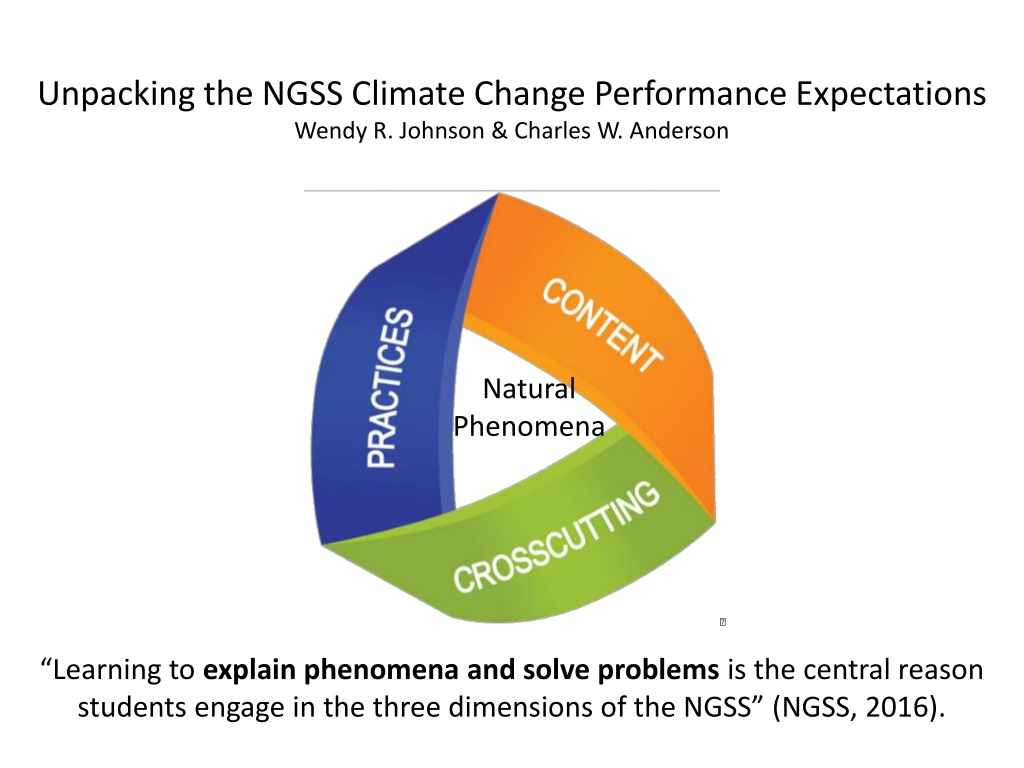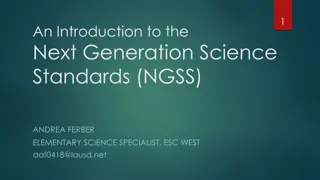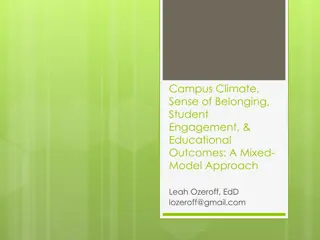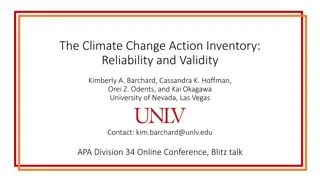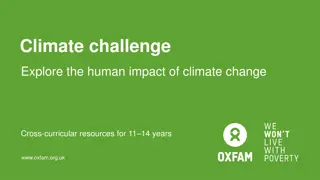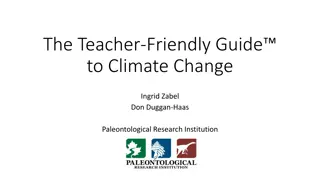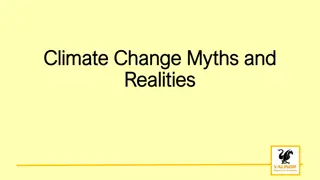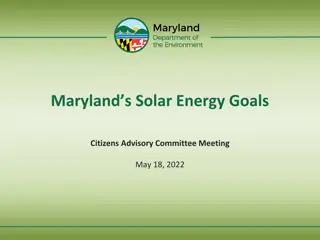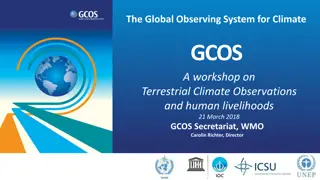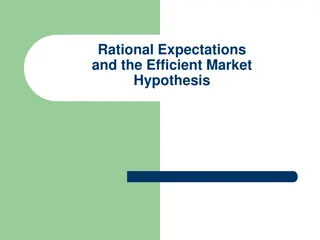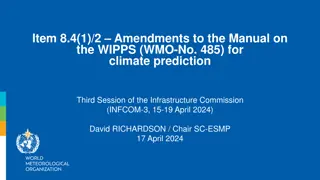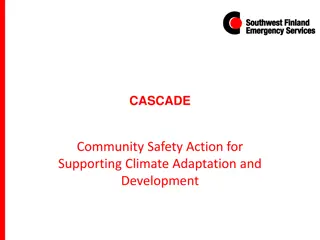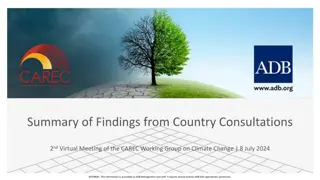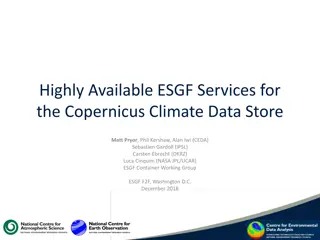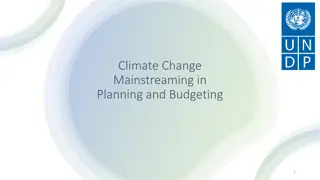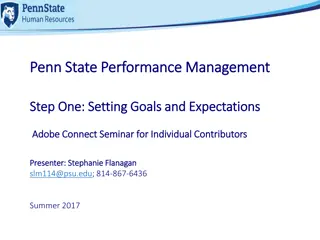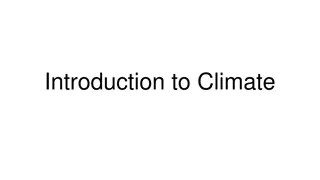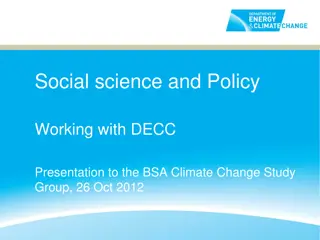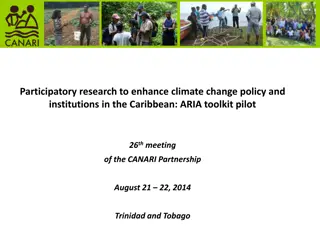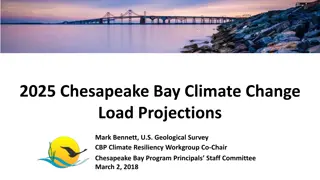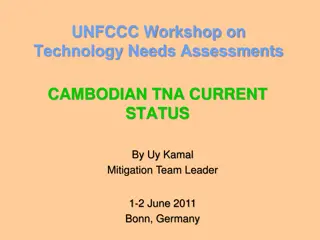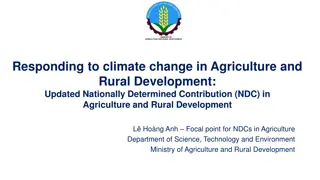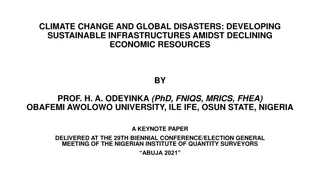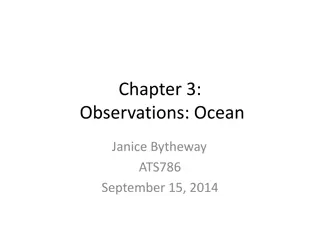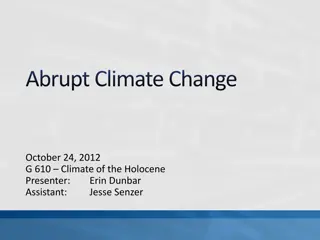Unpacking NGSS Climate Change Performance Expectations for Student Engagement
Explore the interconnected three dimensions of NGSS by delving into the performance expectations related to climate change. Understand the role of students in explaining phenomena and solving problems, with a focus on global temperature rise, carbon cycling, and Earth system interactions. Prepare students for future learning and citizenship through a storyline of human impact on the environment.
Download Presentation

Please find below an Image/Link to download the presentation.
The content on the website is provided AS IS for your information and personal use only. It may not be sold, licensed, or shared on other websites without obtaining consent from the author. Download presentation by click this link. If you encounter any issues during the download, it is possible that the publisher has removed the file from their server.
E N D
Presentation Transcript
Unpacking the NGSS Climate Change Performance Expectations Wendy R. Johnson & Charles W. Anderson Natural Phenomena ? Learning to explain phenomena and solve problems is the central reason students engage in the three dimensions of the NGSS (NGSS, 2016).
Performance Expectation DCI SEP CCC Connections to Other DCIs MS.PS3.A, HS.PS3.B, HS.PS4.B, HS.ESS2.A, HS.ESS2.D, HS.ESS3.C MS-ESS3-5. Ask questions to determine the factors that have caused the rise in global temperatures over the past century. ESS3.D Global climate change Asking questions & defining problems Stability & change HS.PS3.B, HS.PS4.B, HS.LS2.B, HS.LS2.C, HS.LS4.D, HS.ESS3.C, HS. ESS3.D, MS.PS3.D, MS.PS4.B, MS.LS2.B, MS.LS2.C, MS.LS4.C, MS.ESS2.A, MS.ESS2.B, MS.ESS2.C, MSESS2.D, MS.ESS3.C, MS.ESS3.D HS.PS3.A, HS.PS3.B, HS.LS2.C, HS.ESS1.C, HS.ESS3.C, HS.ESS3.D, MSPS3.A, MSPS3.B, MSPS3.D, MSPS4.B, MSLS1.C, MSLS2.A, MSLS2.C, MSESS2.A, MSESS2.B, MSESS2.C, MSESS2.D, MSESS3.C, MSESS3.D HS-ESS2-2. Analyze geoscience data to make the claim that one change to Earth s surface can create feedbacks that cause changes to other Earth systems. ESS2.D Weather and climate (also ESS2.A) Analyzing & interpreting data Stability & change HS-ESS2-4. Use a model to describe how the variations in the flow of energy into and out of Earth systems results in changes in climate. ESS2.D Weather and climate (also ESS2.A & ESS1.B) Developing & using models Cause & effect HS.PS1.A, HS.PS1.B, HS.PS3.D, HS.LS1.C, HS.LS2.B, HS.ESS3.C, HS.ESS3.D, MS.PS1.A, MS.PS3.D, MS.PS4.B, MS.LS2.B HS-ESS2-6. Develop a quantitative model to describe the cycling of carbon among the hydrosphere, atmosphere, geosphere, and biosphere. ESS2.D Weather and climate Developing & using models Energy & matter HS.PS3.B, HS.PS3.D, HS.LS1.C, HS.ESS2.D, MS.PS3.B, MS.PS3.D, MS.ESS2.A, MS.ESS2.D, MS.ESS3.B, MS.ESS3.C, MS.ESS3.D HS-ESS3-5. Analyze geoscience data and the results from global climate models to make an evidence-based forecast of the current rate of global or regional climate change and associated future impacts to Earth systems. HS-ESS3-6. Use a computational representation to illustrate the relationships among Earth systems and how those relationships are being modified due to human activity. ESS3.D Global climate change Analyzing & interpreting data Stability & change HS.LS2.B, HS.LS2.C, HS.LS4.D, HS.ESS2.A, MS.LS2.C, MS.ESS2.A, MS.ESS2.C, MS.ESS3.C, MS.ESS3.D ESS3.D Global climate change (also ESS2.D) Using Mathematics & computational thinking Systems & system models
Unpacking the climate change PEs 1. Looking back what prior knowledge is required? 2. Identifying learning challenges what do students struggle with and why? 3. Looking forward are students prepared for future learning and citizenship?
The PEs can be arranged into a storyline Human combustion of fossil fuels has altered the Earth s natural carbon cycling, leading to a steady buildup of CO2 in the atmosphere (HS-ESS2-6). CO2 and other greenhouse gases affect the movement and transformations of solar energy through Earth systems, leading to increases in temperature (HS-ESS2-4). The changes in climate lead to changes in other Earth systems, including the hydrosphere and the geosphere (HS- ESS3-6). The nature and rates of these changes can be projected into the future (HS-ESS3-5). Rates of change may be altered by positive or negative feedback loops (HS-ESS2-2).
The Keeling Curve: Starting point for HS-ESS2-6 Challenges Representation Patterns & trends Generalizability
How do we explain the Keeling Curve? Balance of photosynthesis and respiration explains the yearly cycle unbalanced flux of CO2 from fossil fuels explains the overall trend Connecting the organismal processes of photosynthesis & respiration to large scale changes CO2 in the atmosphere is very difficult for ALL students
Multiple challenges in the Multiple challenges in the NGSS Performance Expectations Performance Expectations NGSS Explaining the Keeling Curve requires connecting two kinds of complex performances: 1. Interpreting quantitative data representations, including graphs, tables, quantitative models, etc. 2. Constructing explanations of processes in systems using scientific models And this is the easy one! The other performance expectations are even more difficult and challenging.
